
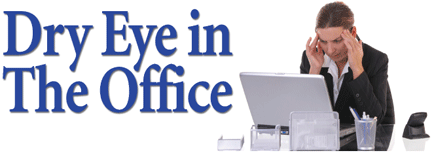
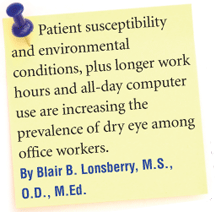
Are you a workaholic? On average, Americans work more hours per year than their counterparts in any other industrialized nation. In the last 20 years, the number of hours that Americans have spent at their jobs has steadily increased.1,2
In addition, with the advent of computers, many employees now spend most of their time performing tasks without moving from the desktop. The increased work week and concentrated computer use has generated considerable research about the negative impact on worker health and safety.
The National Womens Health Research Center recently unveiled the Dry Eye Hot Jobsthe nations first listing of the top 10 job categories with workplace conditions that are most likely to contribute to or aggravate dry eyes.3 Not surprisingly, office-based jobs, such as administrative work, finance and information technology topped the list.
The survey results also revealed that 34% of respondents experienced dry eye symptoms three or more times a day, with 47% regularly feeling that they needed to use over-the-counter (OTC) eye drops to relieve their symptoms. Interestingly, despite this high use of OTC eye drops, 61% of dry eye sufferers had not spoken to their eye-care professional about their symptoms.
Common factors among those who suffered dry eye symptoms were computer use and regular exposure to environmental factors known to aggravate dry eye. The majority reported working in an indoor office setting, with a quarter spending more than 75% of their time in front of the computer.3
Dry eye affects more than 20 million people in the
If left untreated, patients with dry eye may have an increased risk for developing infections and impaired visual function.3 Studies have shown that dry eye syndrome (DES) is associated with a measurable impact on several common and important daily living tasks, making it an important public health concern that deserves increased attention and resource allocation.5,6 The increasing demands of modern living require individuals to perform prolonged visual tasks that may result in the development of DES. The consequences to vision and vision-related quality of life can be detrimental. Indeed, patients report that the effect of dry eyes on their quality of life is similar to severe health conditions, such as angina, dialysis or a disabling hip fracture.5
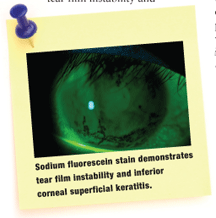 Dry Eye Defined
Dry Eye Defined
The traditional definition of dry eye is a disorder of the tear film that results from tear deficiency or excessive tear evaporation. Tear film deficiency can lead to ocular surface damage and is associated with symptoms of ocular discomfort.7
A more recent definition comes from the International Dry Eye WorkShop (DEWS). The DEWS members felt that the traditional definition didnt take into consideration the latest research with regard to tear hyperosmolarity, ocular surface inflammation, tear instability and the effect on visual function.8 The DEWS definition:
Dry eye is a multifactorial disease of the tears and ocular surface that results in symptoms of discomfort, visual disturbance, and tear film instability with potential damage to the ocular surface. It is accompanied by increased osmolarity of the tear film and inflammation of the ocular surface.8
A crucial aspect of the new definition is the recognition that dry eye goes beyond an aqueous deficient or evaporative problem and includes tear film instability, inflammation and the effect on visual function. The inclusion of tear film instability and its effect on visual function becomes crucial in assessing patients who work in an office environment and spend extended time on the computer. The inclusion of inflammation recognizes a crucial component of how the damage related to dry eyes occurs and opens new lines of treatment.8
Diagnosis of dry eye is often made from patient symptoms and a clinical evaluation of decreased tear production and decreased tear film quality. Symptoms of dry eye include dryness, soreness and irritation, discomfort, itching, burning and stinging, and they usually increase throughout the day.9 Ocular surface damage and conjunctival hyperemia can confirm the diagnosis.10,11
Bear in mind that clinicians may underestimate the severity of their dry eye patients problem due to a poor correlation between the clinical signs and the patients self assessment.11
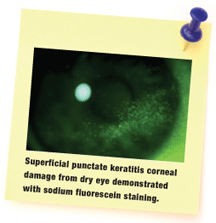 Dry Eye and the Office
Dry Eye and the Office
For those who work in an officeparticularly those who work for prolonged periods of time on a computerocular symptoms may be exacerbated. As computer use becomes an increasing part of our everyday life, the number of patients who experience ocular and visual-related problems has increased. Prior to the introduction of computers, an office worker would have a variety of tasks that demanded breaks from prolonged near work. With more computer use, however, patients are reporting an increase in eyestrain, tired eyes, irritation, redness, blurred vision and double vision. These symptoms have collectively been termed computer vision syndrome (CVS).12
CVS is described as a repetitive strain disorder that includes several non-ocular symptoms, such as headaches and pain in the shoulders, neck and/or back. The visual components of CVS can be broadly broken down into three main causes: ocular surface, accommodative and extraocular muscle.
Intense computer use has been shown to cause diminished power of accommodation, a reduced near point of convergence and a deviation of patients near phoria. These changes in accommodation and vergence function occur after long work periods on the computer, and they can result in complaints of visual fatigue.12
Dry eye resulting from computer use can exacerbate the ocular fatigue symptoms or can be a primary cause of complaint. Several studies have demonstrated that the blink rate in individuals who work on computers can be reduced by more than 50%, when compared with normal conversation blink rates.13,14 Spontaneous blink rate plays a crucial role in the integrity of the ocular surface by spreading the tear film over the entire surface and promoting the drainage of tears. The increased visual attention that is required during near work (reading or computer) can cause a decrease of the spontaneous blink rate, which can result in a poor tear film quality and distribution.15
This disruption is potentially worse among computer users than individuals who typically perform normal reading tasks. Typical reading of text on paper is performed while looking down, resulting in the eyelids covering a substantial part of the ocular surface, and minimizing exposure and evaporation. Computer users generally view their monitors in a near-horizontal position, which results in a wider palpebral fissure with increased surface exposure and evaporation.
Positioning of the computer monitor is an important consideration in minimizing ocular discomfort. Several studies have recommended that the distance to the monitor should be between 35 to 40 inchesshorter distances result in increased eyestrain.12 Also, the monitor should be placed 10 to 20 degrees below (or the middle of the screen five to six inches below) eye level. When placed higher, viewers often tilt their heads back, which can cause neck pain. Additionally, lowering the monitor allows the viewer to gaze downward, which reduces the amount of ocular surface exposed and resulting tissue desiccation.
Regardless of monitor positioning, the patient should be encouraged to take frequent breaks in order to relax the accommodative/vergence systems and stabilize the tear film.12 A study by the National Institute of Occupational Safety and Health found that short, frequent breaks resulted in increased worker productivity by decreasing discomfort. When regular breaks are implemented into a workers schedule, work efficiency improves, usually compensating for the time lost on the break.16
In addition to CVS, other factors affect dry eye in the workplace:
Gender. Female sex and postmenopausal estrogen therapy are important factors in the development of dry eye, as womenparticularly older womenreport dry eye symptoms more often than men.17 Research supports that sex hormones play an important etiology in dry eye, with a generalization that high estrogen and low androgen levels are risk factors.18
Age. Dry eye becomes an increasing problem as the patient ages. Aging, in general, is associated with physiological changes in the eyesuch as decreased tear production (volume) and flow, increased osmolarity, decreased tear film stability, and alterations in meibomian gland functionthat may predispose patients to dry eye. Women are also more likely to have associated systemic conditionssuch as rheumatoid arthritis, systemic lupus erythematosus, Sjgrens syndrome and other associated autoimmune diseasesthat result in secondary dry eye problems.17 The investigational treatments for dry eye that are currently underway focus on androgen therapy, including transdermal testosterone and transdermal progesterone for menopausal women.18
Humidity. Relative humidity may represent an additional risk factor for the development of dry eye. Several studies investigated relative humidity as a precursor of dry eye.19 Important factors that resulted in altered relative humidity and increased dry eye complaints include being adjacent to air conditioning or heating vents, air travel, increased exposure to high wind velocity, and in general any office setting.19 Office temperature was also evaluated, and it was recommended that the temperature be kept at 68 F to 72 F to minimize the effects of altered relative humidity.20
Contact lens wear. Contact lens use is a confounding factor in dry eye sufferers, particularly those who work in an office environment. Contact lens wearers, in general, are more likely to report dryness symptoms, and office workers who wear contact lenses were more likely to suffer a higher severity and frequency of ocular discomfort.21
Contact lens wear interferes with the normal tear film by separating it into two layers, which can result in an increased rate of evaporation, corneal staining, dryness and discomfort. Contact lenses with poor wettability and higher water content have been linked to dry eye symptoms.21 (Lenses with a lower water content appear to have less capacity to dehydrate and can potentially provide higher levels of comfort). Newer silicone hydrogel lenses contain agents to increase wettability of the lens surface and help prevent dehydration (e.g., CIBA Vision Focus Dailies and Acuvue Oasys).
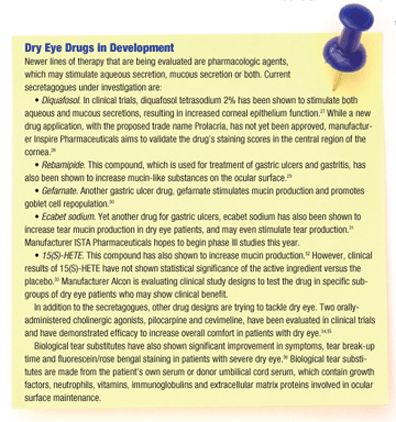
Dry Eye Treatment
Educate office workers who wear contact lenses about the potential associated dry eye issues. Consider the type of contact lens chosen and the use of rewetting agents and disinfecting solutions to improve surface wetting and comfort.21 The primary objective in treating patients with dry eye is to improve ocular comfort and quality of life. To do this, we must return the patients ocular surface and tear film to a normal homeostatic state. A stepwise approach includes one or more of the following:
Topical lubricants. Artificial tears are the most common palliative solution for patients experiencing dry eye symptoms. Different topical lubricants have various viscosities, electrolyte composition, osmolarities and preservatives. The International Dry Eye WorkShop evaluated extensive clinical data on topical lubrication, and it found no evidence to conclude that any agent is superior to another.22 Most clinical trials involving topical lubrication report improved subjective symptoms and improvement in some objective measures.
The elimination of preservatives and development of less toxic preservatives has resulted in topical lubricants that are better tolerated by some patients. However, ocular lubricants still dont entirely resolve the ocular surface damage and inflammation observed in most dry eye patients. Nevertheless, topical lubricants have been shown to provide some protection of the ocular surface and provide improvement in patient symptoms.22
Specifically, there are topical lubricants that
mimic the electrolyte composition of human tears: TheraTears (Advanced Vision Research) and Bion Tears (Alcon).
are hypo-osmotic to counteract the elevated osmolarity in dry eye patients: HypoTears (Novartis Ophthalmics), TheraTears, and Optive (Allergan).
increase viscosity in order to increase ocular surface contact and protection to the ocular surface: Systane (Alcon), Refresh Celluvisc (Allergan), and Soothe XP (Bausch & Lomb).
have no preservative: Tears Naturale Free (Alcon), GenTeal PF (Novartis Ophthalmics), and Refresh Plus (Allergan). Or, have less toxic preservatives: TheraTears and Refresh Tears (Allergan).
Of course, the choice of topical lubricant is often practitioner- and potentially patient-dependent.
Punctal occlusion. Punctal plugs have a documented improvement in patients suffering from dry eye. Their use has been associated with increased subjective and objective improvement in patients with an evaporative form of dry eye.23 Objective indices of improvement include reduced corneal staining, prolonged tear film breakup, increased goblet cell density and decreased tear osmolarity.
Most common complications associated with punctal occlusion use is plug extrusion (primarily Freeman type), followed by internal migration, infection and pyogenic granuloma formation.23
Topical agents. The DEWS members added inflammation to the new definition of dry eye disease, as it can result in ocular surface disease. Corticosteroids are the standard anti-inflammatory agent, and they have shown to preserve corneal epithelium and reduce corneal staining. But, steroids also have known potential side effects, including elevated intraocular pressure, cataract formation, decreased wound healing time and development of infection.22
Additionally, cyclosporine has demonstrated the ability to significantly decrease conjunctival rose bengal staining, superficial punctate keratitis and ocular irritation symptoms. Restasis (cyclosporine 0.05%, Allergan) is the first commercially available medication that has the potential to treat the underlying cause of dry eye by increasing tear production, reducing proinflammatory cytokines and increasing conjunctival goblet cell densities.22,24
Preliminary results of a recent study found that a soft steroid, such as Lotemax (loteprednol 0.5%, Bausch & Lomb), used in conjunction with cyclosporine significantly improves corneal and conjunctival staining and significantly increased tear production compared with a regimen of cyclosporine and artificial tears.25 So, in those patients who have moderate to severe dry eye disease, consider a course of topical corticosteroids and cyclosporine to suppress any inflammation.26
Nutritional supplements. Essential fatty acids are a necessary component of a healthy diet. They cannot be synthesized by humans and must be obtained from dietary sources. Omega-3 fatty acids have been observed to significantly improve ocular irritation symptoms and ocular surface lissamine green staining in several clinical investigations.22
Dry eye is a significant health care concern, particularly for workers who spend most of their day in an office and in front of a computer. Studies have shown that dry eye can result in diminished quality of life, decreased productivity and potential long-term complications. Proactive options should focus on reducing the contributing factors to the development of dry eye. Patient education should include encouraging frequent breaks, computer monitor placement, and office environment or ergonomic factors.
When patients experience subjective or objective signs and symptoms of dry eye, treatment options include topical lubricants, punctal occlusion, anti-inflammatory agents, solutions that increase tear component secretions, biological substitutes and fatty-acid supplements.
Dr. Lonsberry is clinic director of the
1. Walker T. Americans work longest hours among industrialized countries. ILO News. September 6, 1999. Available at: www.hartford-hwp.com/archives/26/077.html (Accessed January 10, 2008).
2. Schor JB. The Overworked American. The Unexpected Decline of Leisure.
3. Office-Based Positions Lead Dry Eye Hot Jobs: National Listing Unveils Job Categories That Can Aggravate a Condition Affecting More Than 20 Million Americans. Press Release. July 10, 2007. National Womens Health Resource Center Web site. Available at: www.healthywomen.org/newsroom/pressreleases/dbnwhrcnews/dryeyehotjobsnationallisting (Accessed January 10, 2008).
4. Market Scope. Report on the Global Dry Eye Market.
5. Miljanovic B, Dana R, Sullivan D, Schaumberg D. Impact of dry eye syndrome on vision-related quality of life. Am J Ophthalmol 2007 Mar;143(3):409-15.
6. Buchholz P, Steeds DS, Stern LS, et. al. Utility assessment to measure the impact of dry eye disease. Ocul Surf 2006 Jul;4(3):155-61.
7. Lemp MA. Report of the National Eye Institute/Industry workshop on Clinical Trials in Dry Eyes. CLAO J 1995 Oct;21(4):221-32.
8. The definition and classification of dry eye disease: report of the Definition and Classification Subcommittee of the International Dry Eye WorkShop (2007). Ocul Surf 2007 Apr;5(2):75-92.
9. Nichols KK. Patient-reported symptoms in dry eye disease. Ocul Surf 2006 Jul;4(3):137-45.
10. The epidemiology of dry eye disease: report of the Epidemiology Subcommittee of the International Dry Eye WorkShop (2007). Ocul Surf 2007 Apr;5(2):93-107.
11. Chalmers RL, Begley CG, Edrington T, et al. The agreement between self-assessment and clinician assessment of dry eye severity. Cornea 2005 Oct;24(7):804-10.
12. Blehm C, Vishnu S, Khattak A, et al. Computer vision syndrome: A review. Surv Ophthalmol 2005 May-Jun;50(3):253-62.
13. Acosta MC, Gallar J, Belmonte C. The influence of eye solutions on blinking and ocular comfort at rest and during work at video display terminals. Exp Eye Res 1999 Jun;68(6):663-9.
14. Patel S, Henderson R, Bradley L, Galloway B. Effect of visual display unit use on blink rate and tear stability. Optom Vis Sci 1991 Nov;68(11):888-92.
15. Schlote T, Kadner G, Freundenthaler N. Marked reduction and distinct patterns of eye blinking in patients with moderately dry eyes during video display terminal use. Graefes Arch Clin Exp Ophthalmol 2004 Apr;242(4):306-12.
16. Sellers D. 25 Steps to Safe Computing.
17. Schaumberg DA, Sullivan DA, Buring JE, Dana MR. Prevalence of dry eye syndrome among US women. Am J Ophthalmol 2003 Aug;136(2):318-26.
18. Versura P,
19. Wolkoff P, Nojgaard JK, Franck C, Skov P. The modern office environment desiccates the eyes? Indoor Air 2006 Aug;16(4):258-65.
20. Wolkoff P,
21. Fonn D. Targeting contact lens induced dryness and discomfort: what properties will make lenses more comfortable. Optom Vis Sci 2007 Apr;84(4):279-85.
22. Management and therapy of dry eye disease: report of the Management and Therapy Subcommittee of the International Dry Eye WorkShop (2007). Ocul Surf 2007 Apr;5(2):163-78.
23. Taban M, Chen B, Perry JD. Update on punctual plugs. Compr Ophthalmol Update 2006 Sep-Oct;7(5):205-12; discussion 213-4.
24. Foulks GN. Topical cyclosporine for treatment of ocular surface disease. Treatment of Ocular Surface Disease. Int Ophthalmol Clin 2006 Fall;46(4):105-22.
25. Bausch & Lomb. Preliminary results show lotemax with topical cyclosporine to be effective for relief of dry eye signs and symptoms. Press release. December 5, 2007.
26. Behrens A, Doyle JJ, Stern L, et al. Dysfunctional tear syndrome study group. Dysfunctional tear syndrome. A
27. Tauber J, Davitt WF, Bokosky JE, et al. Double-masked, placebo-controlled safety and efficacy trial of diquafosol tetrasodium (INS365) ophthalmic solution for the treatment of dry eye. Cornea 2004 Nov;23(8):784-92.
28. Inspire Pharmaceuticals. Inspire reports first quarter 2007 financial results. Press release. May 9, 2007.
29. Urashima H, Okamoto T, Takeji Y, et al. Rebamipide increases the amount of mucin-like substances on the conjunctiva and cornea in the N-acetylcysteine-treated in vivo model. Cornea 2004 Aug;23(6):613-9.
30. Toshida H, Nakata K, Hamano T, et al. Gefarnate stimulates goblet cell repopulation following an experimental wound to the tarsal conjunctiva in the dry eye rabbit. Adv Exp Med Biol 2002;506(Pt A):353-7.
31. ISTA Pharmaceuticals. ISTA Pharmaceuticals announces positive preliminary results from ecabet sodium phase IIb study. Press release. May 31, 2007.
32. Gamache DA, Wei ZY, Weimer LK, et al. Corneal protection by the ocular mucin secretagogue 15(S)-HETE in a rabbit model of desiccation-induced corneal defect. J Ocul Pharmacol Ther 2002 Aug;18(4):349-61.
33. Alcon Inc. Alcons fourth quarter sales rise 10.7 percent. Press release. February 8, 2006.
34. Aragona P, Di Pietro R, Spinella R, Mobrici M. Conjunctival epithelium improvement after systemic pilocarpine in patients with Sjogrens syndrome. Br J Ophthalmol 2006 Feb;90(2):166-70.
35. Ono M, Takamura E, Shinozaki K, et al. Therapeutic effect of cevimeline on dry eye in patients with Sjgrens syndrome: a randomized, double-blind clinical study. Am J Ophthalmol 2004 Jul;138(1):6-17.
36. Yoon KC, Heo H,

